Deck wood is a great addition to any outdoor space, creating a beautiful and functional area for relaxation and entertainment. However, like any other type of wood, deck wood can suffer from rotting if not properly maintained. Rotting wood needs to look more appealing and compromise your deck’s structural integrity, making it unsafe to use.
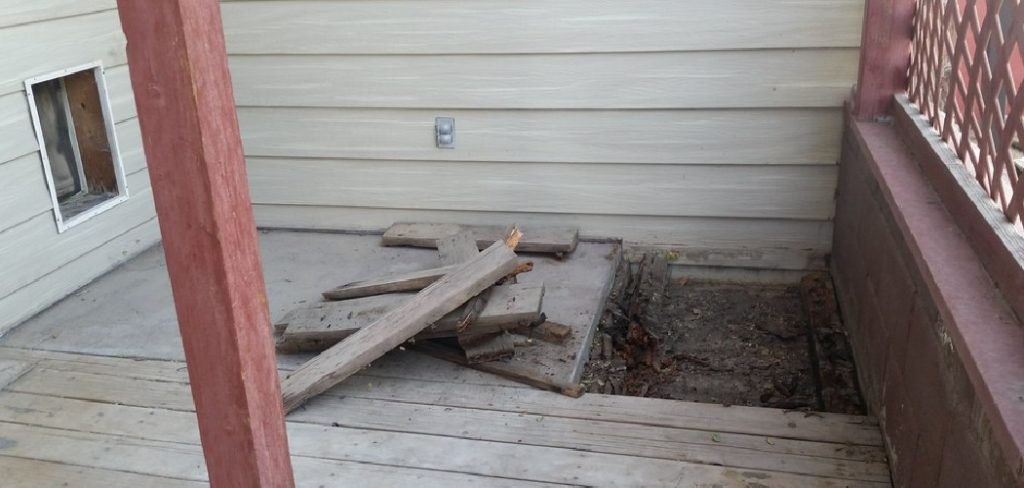
If you are still determining whether your deck wood is rotten or not, there are some signs you can look out for. This guide will discuss how to tell if deck wood is rotten and what steps you can take to fix the problem. So, let’s dive in and learn how to keep your deck wood in top condition.
Understanding Deck Wood
Before identifying rot in deck wood, it’s essential to understand what it is and how it can be susceptible to rot. Deck wood is typically made from pressure-treated lumber, cedar, or redwood, as these types of wood are more resistant to decay and insect damage. However, even with proper treatment, moisture and exposure to the elements can still cause the wood to rot over time.
Moisture is the number one enemy of deck wood, as it can seep into the wood’s fibers and create a breeding ground for fungi that cause rot. This moisture can come from rain, snow, or even sprinkler systems. Also, humidity levels can increase and contribute to rotting wood if your deck needs to be properly ventilated.
11 Best Ways on How to Tell if Deck Wood is Rotten:
1. Soft Spots:
One of the most obvious signs of rot in deck wood is when the wood becomes soft and spongy to the touch. If you notice any areas on your deck that feel softer than the rest, it clearly indicates that rot is present. Use a screwdriver to gently poke at these soft spots; if it easily sinks into the wood, it’s most likely rotten. This technique can be used to test the entire deck surface. This is also a good time to inspect the wood for any visible signs of fungi or mold growth.
2. Discoloration of Wood:
Another way to identify rot in deck wood is through discoloration. If you notice a darkened or blackened area on the wood, this could signify rotting. This discoloration occurs as the fungi break down the wood fibers, leaving behind a discolored and weakened surface. Keep in mind that not all discoloration indicates rot, so it’s best to use other methods to confirm. This is especially true for cedar and redwood, as they can naturally turn darker but not necessarily be rotten.
3. Foul Odor:
Rotting wood tends to have a distinct musty odor that is hard to miss. If you notice an unpleasant smell coming from your deck, the wood has likely started to rot. This is due to the fungi breaking down the wood fibers, releasing gases that create a foul odor. If you can detect a musty smell even from a distance, it’s time to check for other signs of rot. If left untreated, the smell will only worsen and spread to other areas of your deck.
4. Cracks and Splits:
As wood starts to rot, it becomes weaker and more prone to cracking and splitting. If you notice any cracks or splits in your deck wood, it’s a sign that the wood may be compromised by rot. These cracks can also allow moisture to enter the wood, accelerating the rotting process. Be sure to check for any cracks or splits in both the wood surface and the support beams underneath.
5. Hollow Sound:
You can also use a more unconventional method to test for rot by tapping on the wood surface with a hammer. If you hear a hollow sound instead of a solid thud, it’s a sign that the wood has started to rot. The rotting process eats away at the inner layers of the wood, leaving behind only a thin outer layer. Again, you can test this on various areas of your deck to better understand where the rot may be present.
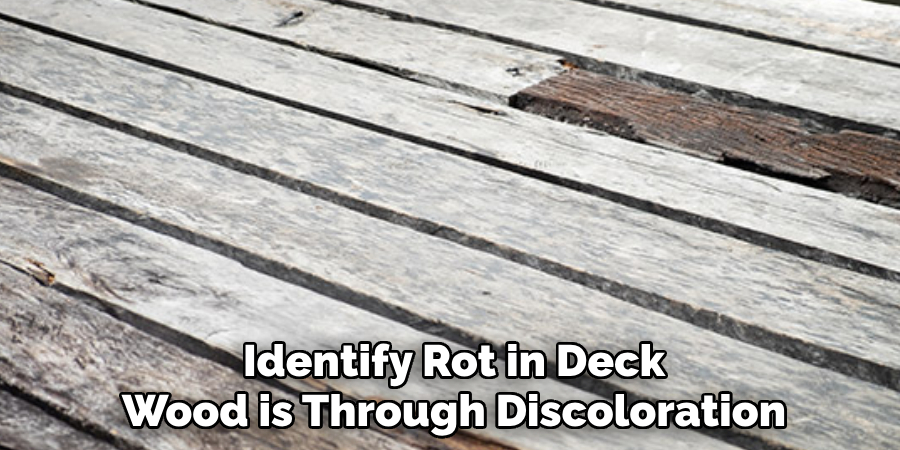
6. Wood Damage:
If you notice any visible damage to the wood, such as peeling or cracking paint, it’s a sign that the wood may be rotting. Painting and staining can help protect deck wood from moisture, but if there is already damage to the wood, it could indicate the presence of rot. Be sure to regularly inspect your deck for any signs of damage and address them promptly to prevent further issues.
7. Insect Activity:
Insects are attracted to damp and rotting wood, making them a common sign of deck wood rot. Look out for signs of insect activity, such as holes or tunnels on the surface of the wood or piles of sawdust (known as frass) around the deck. These insects can further damage the already weakened wood, so it’s crucial to address the rot and insect infestation simultaneously.
8. Discolored Nails:
If your deck is constructed with nails instead of screws, check for any discoloration around the nail heads. If you notice a rusty or dark-colored stain, it could be a sign that moisture has entered through the nail holes, causing rot in the surrounding wood. This is another reason why it’s essential to use corrosion-resistant fasteners when building a deck.
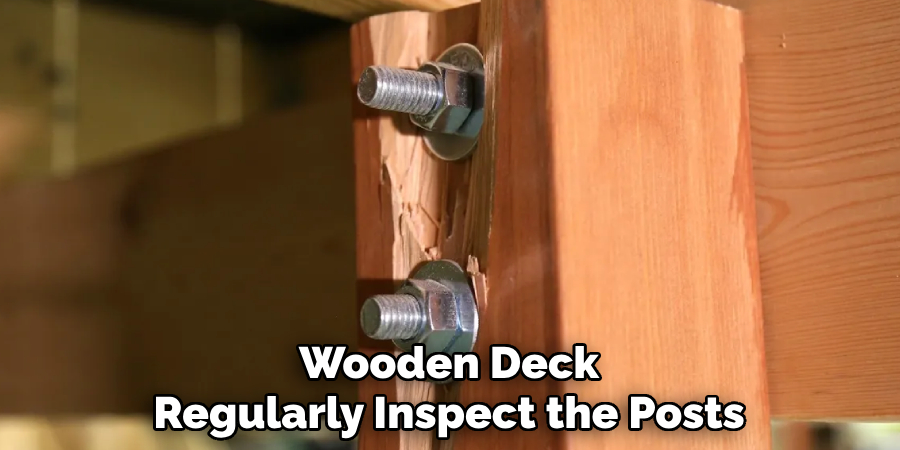
9. Wobbly Rails:
Deck rails are one of the most critical safety features, so it’s crucial to check them regularly for signs of rot. If you notice that your railings feel loose or wobbly, it could be due to rot in the supporting posts or connectors. This is a dangerous situation, and you should immediately stop using the deck until the issue is fixed.
10. Sinking Deck:
If your deck feels like it’s sinking in certain areas, it’s a sign that the structural support beams may be rotting. The weight of the deck and its occupants can put pressure on these weakened beams, causing them to sink or give way. If you notice any unevenness in your deck surface, it’s essential to have a professional inspect the underlying structure for rot and reinforce it if necessary.
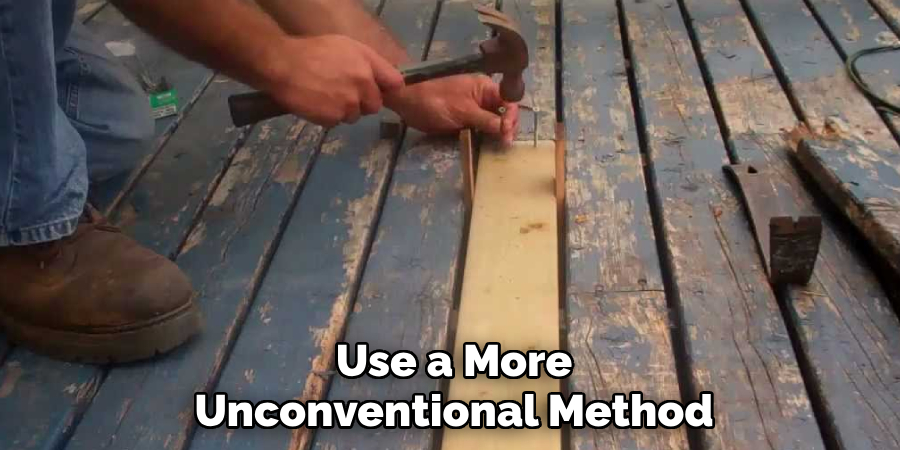
11. Age of Deck:
Finally, one of the best ways to tell if your deck wood is rotten is by considering its age. Most decks are built to last around 10-15 years, depending on the type of wood and maintenance. If your deck is reaching this age or has exceeded it, it’s critical to regularly inspect for signs of rot and address them promptly. Proper maintenance can help prolong the life of your deck, but eventually, all wood will start to deteriorate over time.
Following these 11 ways how to tell if deck wood is rotten can help you identify and address the issue before it becomes a safety hazard. Regularly inspecting your deck for signs of rot and addressing them promptly through proper maintenance can help prolong its lifespan and ensure the safety of anyone using it. Remember, prevention is always better than trying to fix a major issue later on. So, be sure to take care of your deck and keep an eye out for any signs of rot. Happy decking! Remember to stay safe and enjoy the outdoors responsibly. Happy decking!
Additional Tips and Tricks to Tell if Deck Wood is Rotten
1. If you notice any discoloration or dark spots on the surface of the wood, it is a sign that moisture has penetrated and caused rot. A musty odor can also accompany this.
2. Use a screwdriver or awl to probe the wood in different areas. If the tool easily sinks into the wood or comes out with debris, it could be an indication of rot.
3. Check for any cracks or splits in the wood, as these can also be entry points for moisture and lead to rotting.
4. Look for signs of insect damage, such as small holes or tunnels on the surface of the wood. Insects can cause significant damage to deck wood and make it more susceptible to rot.
5. If you have a wooden deck, regularly inspect the posts and joists underneath for signs of rot. These areas are often hidden from view and can be more prone to moisture buildup.
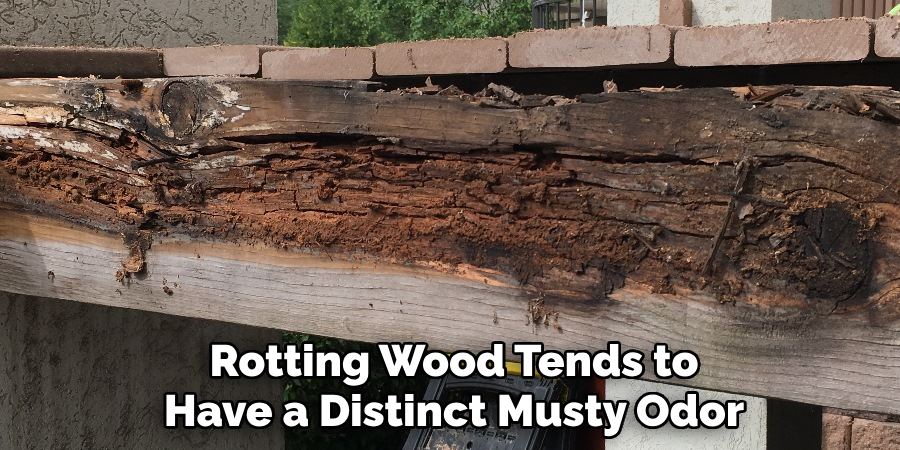
6. Keep your deck clean by regularly sweeping away debris and removing any standing water after rainfall. This will help prevent moisture from accumulating and causing rot.
7. Consider treating your deck with a sealant or water repellent to protect against moisture and prolong its lifespan. This is especially important for decks that are exposed to harsh weather conditions.
8. Regularly inspect and maintain any plants or shrubs growing near your deck, as their roots can cause damage to the wood if they grow too close.
9. If you notice any areas of rot, it’s best to address them immediately before they spread and cause further damage. This may require replacing or treating the affected wood with a wood hardener.
Following these tips can help you identify and prevent rot in your deck wood, ensuring that it remains safe and sturdy for years to come. Remember to regularly inspect your deck and address any issues as soon as they arise to avoid costly repairs in the future. With proper maintenance, your deck can be a beautiful and functional outdoor space for your home. So, pay attention to any signs of rot and take the necessary steps to keep your deck in top condition. Happy decking!
Things You Should Consider to Tell if Deck Wood is Rotten
1. The first thing you should consider when trying to tell if deck wood is rotten is its appearance. Look for any visible signs of decay, such as discoloration, soft spots, or cracks in the surface.
2. Another important factor to consider is the age of the deck. Wood naturally decays over time, so older decks are more likely to have rotting wood than newer ones. If your deck is over ten years old, inspecting the wood for signs of rot is a good idea.
3. Check for any water damage or moisture in the wood. Rot thrives in damp environments, so if your deck has been exposed to excess moisture, it’s more likely to have rotted wood.
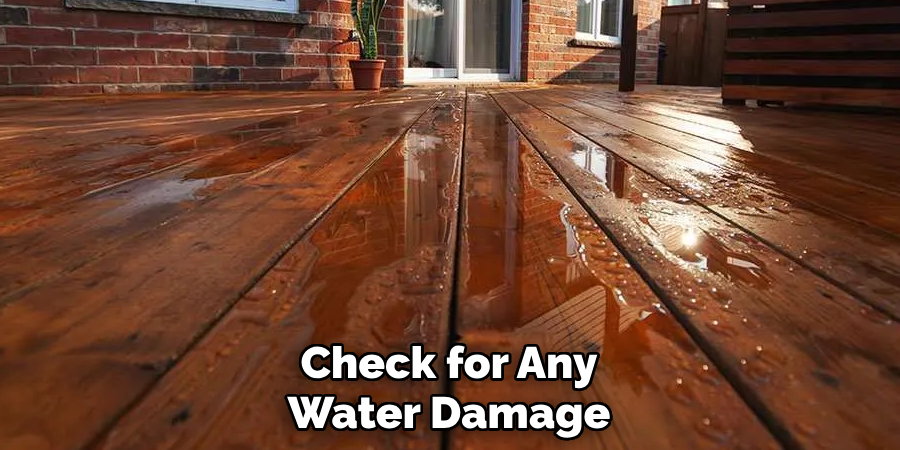
4. Use a screwdriver or other sharp tool to probe the wood. Rotten wood will feel soft and spongy, while healthy wood should be firm and hard. If you can easily push the tool into the wood or if it breaks apart, it’s a sign of rot.
5. Pay attention to any strange odors coming from your deck. Rotting wood often has a musty smell that is difficult to ignore.
6. Look for any signs of insect infestation, which can also contribute to wood rot. Termites, carpenter ants, and other insects are attracted to decaying wood and can further damage already weakened areas.
7. Inspect the support beams and joists underneath the deck as well. These areas are often more prone to rotting due to their exposure to moisture and lack of ventilation.
8. Regularly maintain and seal your deck to prevent water damage and prolong its lifespan. This can help prevent wood rot in the future.
9. If you suspect your deck wood is rotten, it’s important to address the issue immediately to prevent further damage and potential safety hazards. Consult a professional if necessary for proper treatment and repairs.
10. regularly inspecting your deck for any signs of damage or decay is always a good idea. Catching and addressing issues early on can save you time and money in the long run.

11. Consider using alternative materials for your deck, such as composite decking or pressure-treated wood, which are more resistant to rotting and require less maintenance.
Following these considerations can help you determine if your deck wood is rotten and take the necessary steps to address the issue. Remember, proper maintenance and regular inspections are key to ensuring the safety and longevity of your deck. So, make sure to keep an eye on your deck’s health and address any concerns promptly. Happy decking!
Frequently Asked Questions
How Do I Know if My Deck Wood is Rotten?
The easiest way to tell if your deck wood is rotten is to inspect it for signs of decay. These can include discoloration, soft spots, or a musty odor. You should also check for any visible cracks or holes in the wood. If you notice any of these signs, it’s likely that your deck wood is rotten.
Can I Repair Rotten Deck Wood?
In some cases, rotten deck wood can be repaired. However, the extent of the damage will determine whether repair is possible or if replacement is necessary. Small patches of rot can sometimes be removed and filled with wood putty, but larger areas may require the replacement of the affected boards.
How Does Deck Wood Become Rotten?
There are a few different factors that can contribute to deck wood becoming rotten. Moisture is the main culprit, as it can seep into the wood and cause it to deteriorate over time. Poor drainage, lack of ventilation, and exposure to harsh weather conditions can all contribute to moisture build-up and ultimately lead to rot.
How Can I Prevent Deck Wood from Becoming Rotten?
Proper care is important to prevent your deck wood from becoming rotten. This includes regular cleaning and sealing and ensuring proper drainage and ventilation. It’s also a good idea to inspect your deck regularly for any signs of decay or damage so that you can address them before they become a bigger issue.
What Should I Do if My Deck Wood is Rotten?
If you suspect your deck wood is rotten, it is important to address the issue as soon as possible. Ignoring it can not only lead to further damage and safety hazards, but it can also be more costly in the long run. Consult a professional to determine the best action for repairing or replacing your deck wood. They may also recommend ways to prevent rot from occurring again in the future.
Can I Use Alternative Materials for My Deck?
Yes, alternative decking materials are more resistant to rot and require less maintenance. Composite decking and pressure-treated wood are two popular options that can help prolong the lifespan of your deck. However, it’s still important to regularly inspect and maintain these materials to prevent any potential issues. Ultimately, the best option for your deck will depend on your budget, personal preferences, and the climate in which you live. Be sure to research and consult a professional before making any decisions.
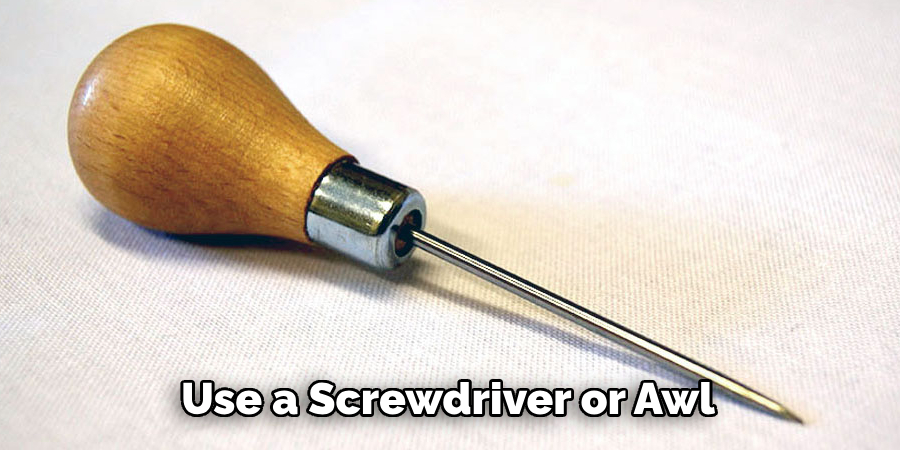
Conclusion
Now you know how to tell if deck wood is rotten and what steps to take if you find it. Regular maintenance and proper care can go a long way in preventing rot and prolonging the life of your deck. If you notice any signs of decay, be sure to address them promptly to avoid more extensive damage.
With the right attention and upkeep, you can enjoy a beautiful and safe deck for years to come. So get out there and enjoy your outdoor space without worrying about rotting deck wood! Remember these tips, and you’ll have a long-lasting, sturdy deck for all your outdoor gatherings. Happy decking!
About the Author
Adrian Green, a lifelong woodworking enthusiast, shares his passion for the craft through The Woodenify Blog. With a foundation built on years of hands-on experience in his father’s woodworking shop, Adrian is dedicated to helping others learn and grow in the world of DIY woodworking. His approach to woodworking combines creativity, practicality, and a deep appreciation for the art of building with your own hands. Through his blog, he inspires individuals of all skill levels to embark on their own woodworking journeys, creating beautiful, functional pieces of furniture and décor.
Professional Focus
- Specializes in DIY woodworking projects, from furniture to home décor.
- Provides step-by-step guides and practical tutorials for woodworkers of all skill levels.
- Dedicated to helping readers build confidence and skill through easy-to-follow instructions and tips.
- Passionate about fostering a community of makers who can share, learn, and grow together.
Education History
- University of Craft and Design – Bachelor of Fine Arts (BFA) in Woodworking and Furniture Design
- Woodworking Apprenticeships – Extensive hands-on training with skilled craftsmen to refine carpentry and furniture making techniques.
- Online Courses & Masterclasses – Continued education in advanced woodworking techniques, design principles, and specialized tools
Expertise:
- DIY woodworking, carpentry, furniture making, and home décor projects.
- Creating accessible tutorials and guides for beginner to advanced woodworkers.
- Sharing the joys and satisfaction of woodworking, from raw materials to finished products.
